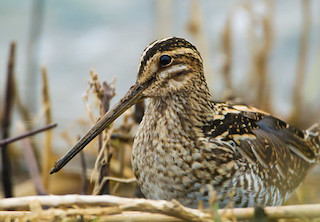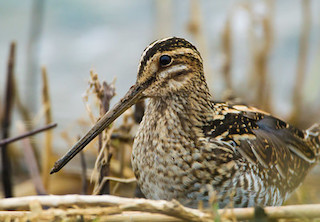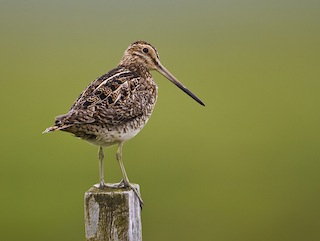 It may be a relatively common wader, but the shy Snipe can be hard to spot. Watch out for it round well-vegetated pool edges on The Lizard, but you need to be patient.
It may be a relatively common wader, but the shy Snipe can be hard to spot. Watch out for it round well-vegetated pool edges on The Lizard, but you need to be patient.
Photo: © Natural England/Allan Drewitt
Scientific name: Gallinago gallinago
Other common names: Common Snipe, Heather-bleater (in Scotland), Sky Goat (translated from the Finnish). See Did you know…? below for the reason for these curious local names.
Conservation status: IUCN Red List, Least Concern; UK Birds of Conservation Concern, Amber
What to look for:
- Colouring and appearance: A squat-looking chestnut-brown wader with white underparts, white-edged wings, short green-ish legs, a dark stripe surrounding the eye and stripes on its head and body. The very straight, long bill is distinctive, and is at least two times the length of the head.
- Size: Length 23 to 28 cm, wingspan 39 to 45 cm.
- Where: Wetlands and moorlands in the breeding season; in winter or migration may be spotted in wider variety of areas, including ditches, pond edges, seashore.
- Call: Song, in flight and on ground.
- Similar species: Great Snipe, which is only slightly larger, but can be distinguished by barring on its belly (the Common Snipe’s is an unbarred white). The Jack Snipe, seen on passage or overwintering, has similar markings, but is smaller and with a noticeably shorter bill.
 Although it is a widespread species in the UK, it can be hard work spotting the shy Snipe, a wader that prefers to skulk under the protective cover of vegetation. In the winter, it is a bird that can reward the patient observer who is prepared to sit and wait quietly for the Snipe to emerge from the undergrowth round a lake margin, probing the mud for its invertebrate prey. The beginning and end of the day are the best time to search. When startled from its hiding place, a Snipe will fly away in a jerky zig-zag style, hoping to confuse predators.
Although it is a widespread species in the UK, it can be hard work spotting the shy Snipe, a wader that prefers to skulk under the protective cover of vegetation. In the winter, it is a bird that can reward the patient observer who is prepared to sit and wait quietly for the Snipe to emerge from the undergrowth round a lake margin, probing the mud for its invertebrate prey. The beginning and end of the day are the best time to search. When startled from its hiding place, a Snipe will fly away in a jerky zig-zag style, hoping to confuse predators.
In the spring and summer breeding season, the Snipe can be found on moorland and wet meadows throughout its range of northern Europe, Canada, Alaska and Asia. In the UK, it is more abundant in the north but a sizeable number breed in the southwest. The nest, a basic scrape, is hidden amongst vegetation on the ground and defended by both parents while the clutch of two to five dark-brown spotted eggs is incubated by the female. The parents literally share the care of the newly hatched young, splitting up and each taking responsibility for half the number of chicks without any further contact between the pair.
 Snipes are migratory and, although resident in the UK, numbers are swollen in the winter by the arrival of birds from further north, including from Iceland and the Pharaoh Isles. There are threats to the Snipe across its range, primarily from habitat destruction through marshland drainage and agricultural intensification, and also, in some locations, by nest predation. They are Amber-listed in the UK due to moderate declines in the breeding population over the last 25 years. Snipe are a gamebird and can be shot outside the breeding season (the open season is from August 12th (September 1st in Northern Ireland and the Isle of Man) to January 31st.
Snipes are migratory and, although resident in the UK, numbers are swollen in the winter by the arrival of birds from further north, including from Iceland and the Pharaoh Isles. There are threats to the Snipe across its range, primarily from habitat destruction through marshland drainage and agricultural intensification, and also, in some locations, by nest predation. They are Amber-listed in the UK due to moderate declines in the breeding population over the last 25 years. Snipe are a gamebird and can be shot outside the breeding season (the open season is from August 12th (September 1st in Northern Ireland and the Isle of Man) to January 31st.
Did you know…?
…The courtship flight of the male involves flying in circles and shallow rapid dives, during which it makes a curious drumming noise by vibrating its tail feathers. This sound has been likened to the bleats of a sheep or goat, and this is referenced in some of the local names for the Snipe, such as Heather-bleater in Scotland and Sky Goat (Taivaanvuohi) in Finland.
…Snipes can find food under the mud by touch, using the sensitive tip of their bill.
More information and references:
Svensson, L., Mullarney, K., Zetterstrom, D.,1986. Collins Bird Guide, second edition (translated by Christie, D., Svensson, L.). HarperCollins, London.
Published: September 2014
Author: Amanda Scott
Photos: © Natural England/Allan Drewitt
